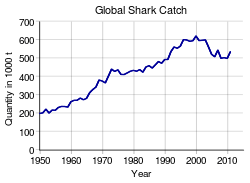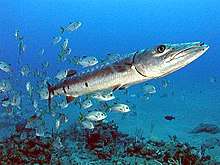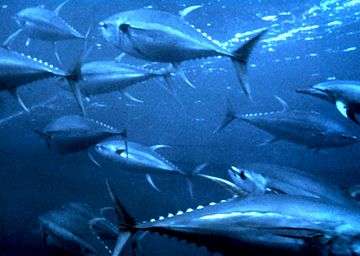Shark finning
Shark finning is the act of removing fins from sharks and discarding the rest of the shark back into the ocean. The sharks are often still alive when discarded, but without their fins.[1][2][3] Unable to swim effectively, they sink to the bottom of the ocean and die of suffocation or are eaten by other predators. Shark finning at sea enables fishing vessels to increase profitability and increase the number of sharks harvested, as they must only store and transport the fins, by far the most profitable part of the shark; the shark meat is bulky to transport.[4] Some countries have banned this practice and require the whole shark to be brought back to port before removing the fins.
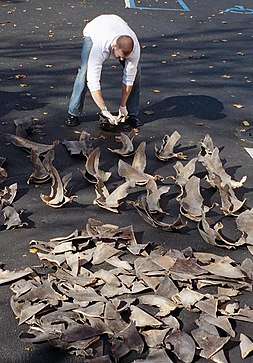

Shark finning increased since 1997 largely due to the increasing demand for shark fins for shark fin soup and traditional cures, particularly in China and its territories, and as a result of improved fishing technology and market economics. The International Union for Conservation of Nature's Shark Specialist Group say that shark finning is widespread, and that "the rapidly expanding and largely unregulated shark fin trade represents one of the most serious threats to shark populations worldwide".[5] Estimates of the global value of the shark fin trade range from US$540 million[4] to US$1.2 billion (2007).[6] Shark fins are among the most expensive seafood products, commonly retailing at US$400 per kg.[5] In the United States, where finning is prohibited, some buyers regard the whale shark and the basking shark as trophy species, and pay $10,000 to $20,000 for a fin.[7]
The regulated global catch of sharks reported to the Food and Agriculture Organization of the United Nations has been stable in recent years at an annual average just over 500,000 tonnes. Additional unregulated and unreported catches are thought to be common.[8]
Shark finning has caused catastrophic harm to the marine ecosystem.[9] Roughly 73-100 million sharks are killed each year by finning.[9][10] A variety of shark species are threatened by shark finning, including the endangered scalloped hammerhead shark.[10]
Process
Nearly every fin of a shark is targeted for harvest, as highlighted in the diagram. The primary and secondary dorsal fins are removed from the top of the shark, plus its pectoral fins, and, in a single cutting motion, the pelvic fin, anal fin, and bottom portion of its caudal fin, or tail.[11]
Because the rest of the shark has little value relative to that of its fins, sharks are sometimes finned while fishing vessels are still at sea, and the finless and often still-living shark is thrown back into the sea to free space aboard the vessel.[12] In legal contexts the use of the term "shark finning" can refer specifically to this practice of removing the fins from live sharks and discarding the carcass while still at sea.[13] For these legal purposes the removal of fins on land during catch processing is not necessarily considered to be shark finning.[13]
Shark species that are commonly finned are:[2][11]
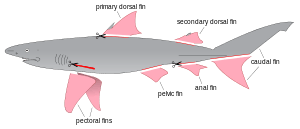
- Blacktip (Carcharhinus limbatus)
- Blue (Prionace glauca) (a species of requiem shark)
- Bull (Carcharhinus leucas) (a species of requiem shark)
- Hammerhead (family Sphyrnidae)
- Oceanic whitetip (Carcharhinus longimanus) (a species of requiem shark)
- Porbeagle (Lamna nasus) (a species of mackerel shark)
- Mako (Isurus oxyrinchus) (a species of mackerel shark)
- Sandbar (Carcharhinus plumbeus) (a species of requiem shark)
- Silky (Carcharhinus falciformis) (a species of requiem shark)
- Spinner (Carcharhinus brevipinna (a species of requiem shark)
- Thresher (family Alopiidae)
- Tiger (Galeocerdo cuvier) (a species of requiem shark)
- Great white shark (Carcharodon carcharias) (a species of mackerel shark)
Impacts
On individual sharks
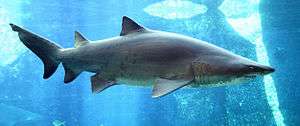
When sharks have been finned, they are likely to die from lack of oxygen because they are not able to move to filter the water through their gills, or are eaten by other fish that have found them defenseless at the bottom of the ocean. Studies suggest that 73 million sharks are finned each year, and scientists have noted that the numbers may be closer to the 100 million mark.[9][10] The majority of shark species exhibit slow growth rates and low reproductive rates, and the rate of reproduction cannot keep pace with the current mortality rate.[15]
On shark populations
Some studies suggest 26 to 73 million sharks are harvested annually for fins. The annual median for the period from 1996 to 2000 was 38 million, which is nearly four times the number recorded by the Food and Agriculture Organization (FAO) of the United Nations,[16] but considerably lower than the estimates of many conservationists.[17] It has been reported that the global shark catch in 2012 was 100 million.[18]
Sharks have a K-selection life history, which means that they tend to grow slowly, reach maturity at a larger size and a later age, and have low reproductive rates.[19] These traits make them especially vulnerable to overfishing methods, such as shark finning. Recent studies suggest changes in abundance of apex predators may have cascading impacts on a variety of ecological processes.
Numbers of some shark species have dropped as much as 80% over the last 50 years.[20] Some organizations claim that shark fishing or bycatch (the unintentional capture of species by other fisheries) is the reason for the decline in some species' populations, and that the market for fins has very little impact – bycatch accounts for an estimated 50% of all sharks taken.[12] Others suggest that the market for shark fin soup is the main reason for the decline.[20]
On other populations
Sharks are apex predators and have extensive implications for marine systems and processes, particularly coral reefs.[21] A report by WildAid on global threats to sharks further explains the importance of these animals.[5]
Fins from the critically endangered sawfish (Pristidae) "are highly favored in Asian markets and are some of the most valuable shark fins".[22] Sawfishes are now protected under the highest protection level of the Convention on International Trade in Endangered Species (CITES), Appendix I.[23]
Live Science said the following:
"The overfishing of sharks [has] serious effects for the entire marine food chain in some ecosystems. [...] [A] study found that removing sharks from a reef environment in the Caribbean had a trickling effect on other species. Without sharks, carnivorous fish that the sharks usually fed on thrived. The carnivorous fish, in turn, preyed on parrotfish that kept the corals clean. In time, the reefs changed from one dominated by coral to one overrun by algae."[9]
Vulnerability of sharks
On the IUCN Red List there are 39 species of elasmobranches (sharks and rays) listed as threatened species (Critically Endangered, Endangered or Vulnerable).[24]
In 2013, the Convention on International Trade in Endangered Species of Wild Fauna and Flora (CITES) listed the vulnerability of sharks.[25][26]
Appendix I, which lists animals that are threatened with extinction, lists
- Requiem sharks (i.e. Tiger Sharks, Bull Sharks, etc.)
- Hammerhead sharks
- Thresher sharks
- Basking sharks
- Mackerel sharks
- Eagle and mobulid rays
- Freshwater stingrays
- Whale sharks[27]
- Sawfishes
Appendix II, which lists animals that are not necessarily now threatened with extinction but that may become so unless trade is closely controlled, lists
- Basking shark (Cetorhinus maximus)
- Great white shark (Carcharodon carcharias)
- Whale shark (Rhincodon typus)
A further five species are listed as of 2014 –
- Scalloped hammerhead (Sphyrna lewini)
- Great hammerhead shark (Sphyrna mokarran)
- Smooth hammerhead (Sphyrna zygaena)
- Porbeagle (Lamna nasus)
- Oceanic whitetip shark (Carcharhinus longimanus)
Opposition

The crew of the Sea Shepherd Conservation Society conservation vessel RV Ocean warrior witnessed and photographed industrial-scale finning within Costa Rica's Cocos Island National Park protected marine area.[28] The practice is featured in the documentary Sharks: Stewards of the Reef, which contains footage from Western Australia and Central America. This documentary also examines shark finning's cultural, financial, and ecological impacts. Underwater photographer Richard Merritt witnessed finning of living sharks in Indonesia where he saw immobile finless sharks lying on the sea bed still alive below the fishing boat.[29] Finning has been witnessed and filmed within a protected marine area in the Raja Ampat islands of Indonesia.[30]
Animal welfare and animal rights groups vigorously oppose finning on moral grounds, as the practice gives sharks a large wound, causes them to slowly die of starvation or drowning,[31] and because finning is one cause for the rapid decline of global shark populations.[12]
Shark finning is sometimes linked to organized crime, including Chinese organized crime syndicates in South Africa,[6][32] Fiji,[6] and Hawaii.[6]
Opponents also raise questions on the medical harm from the consumption of high levels of toxic mercury reportedly found in shark fins.
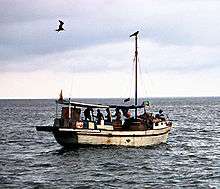
A third of fins imported to Hong Kong come from Europe.[33] Spain is by far the largest supplier, providing between 2,000 and 5,000 metric tons a year.[34][35] Norway supplies 39 metric tonnes, but Britain, France, Portugal, and Italy are also major suppliers.[36] Hong Kong handles at least 50%, and possibly up to 80%, of the world trade in shark fin, with the major suppliers being Europe, Taiwan, Indonesia, Singapore, United Arab Emirates, United States, Yemen, India, Japan, and Mexico.[37] According to Giam's article,[38] "Sharks are caught in virtually all parts of the world.... Despite the strongly declared objectives of the Fisheries Commission in Brussels, there are very few restrictions on fishing for sharks in European waters. The meat of dogfishes, smoothhounds, cat sharks, skates and rays is in high demand by European consumers.... The situation in Canada and the United States is similar: the blue shark is sought after as a sport fish while the porbeagle, mako and spiny dogfish are part of the commercial fishery.... The truth is this: Sharks will continue to be caught and killed on a wide scale by the more organized and sophisticated fishing nations. Targeting shark's fin soup will not stop this accidental catch. The fins from these catches will be thrown away or turned into animal feed and fertilizers if shark's fin soup is shunned."`
In 2007, Canadian filmmaker and photographer Rob Stewart created a film, Sharkwater, which exposes the shark fin industry in detail. In March 2011, the VOA Special English service of the Voice of America broadcast a 15-minute science program on shark finning.
Reporting
According to Giam Choo Hoo – the longest serving member of The Convention on International Trade in Endangered Species of Wild Fauna and Flora Animals Committee,[38] and a representative of the shark fin industry in Singapore[39] – "The perception that it is common practice to kill sharks for only their fins – and to cut them off whilst the sharks are still alive – is wrong.... The vast majority of fins in the market are taken from sharks after their death."[38]
Researchers dispute this claim by pointing to the data: using a statistical analysis of shark fin industry trade data, a 2006 study estimated that between 26 and 73 million sharks are harvested each year worldwide.[40] That figure, when converted to shark biomass, was three to four times higher than the catch recorded in Food and Agriculture Organization capture production statistics, the only global database of shark catches.[41] According to the researchers, this discrepancy "may be attributable to factors... such as unrecorded shark landings, shark biomass recorded in [non-specific] categories, and/or a high frequency of shark finning and carcass disposal at sea."[42] Simply put, they say that the industry is either under-reporting the sharks taken annually, or is frequently engaging in the practice of finning.
International restrictions
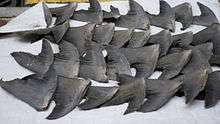
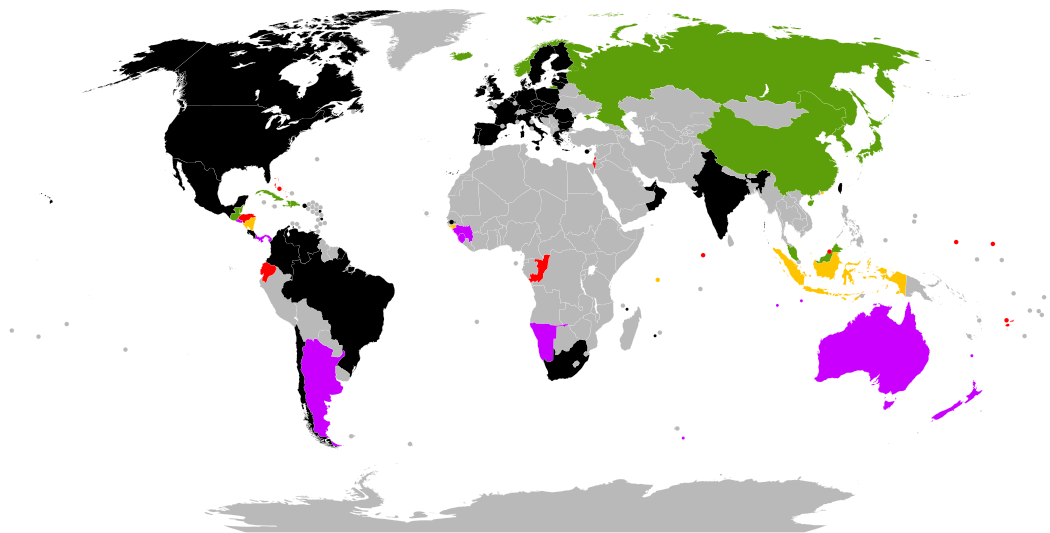
| | Shark fishing is banned | | Shark finning is banned, with extra restrictions1 |
| | Shark finning is banned | | Shark finning is not banned, but there are restrictions2 |
| | Shark finning is legal without restriction | | Unknown |
2Policies include export/import bans or local fishing/finning bans
In 2013, 27 countries and the European Union had banned shark finning;[43] international waters are unregulated. International fishing authorities are considering banning shark fishing (and finning) in the Atlantic Ocean and Mediterranean Sea. Finning is banned in the Eastern Pacific,[44] but shark fishing and finning continues unabated in most of the Pacific and Indian Ocean.[12] In countries such as Thailand and Singapore, public awareness advertisements on finning have reportedly reduced consumption by 25%.
There are four main categories of restrictions, as follows:
- Shark sanctuary (an area where shark fishing is entirely prohibited);
- Areas where sharks must be landed with fins attached;
- Areas where fin to body mass ratio-based regulations have been implemented;
- Areas where shark product trade regulations exist.[45]
European Union
Shark finning was prohibited in the EU in 2003 (Regulation (EC) No 1185/2003).[46]
In November 2011, the EC approved a rule that would require all EU-registered fishing boats to land only sharks which have retained all their fins. Because the legislation allowed fins to be removed on the boat and other body parts to be landed at different ports, the ban proved difficult to enforce. The EU Parliament's fisheries committee supported the EC's proposal to ban the separate landing of shark bodies and fins; however, the committee approved an amendment which allows fins to be removed on board a vessel.[47]
On 19 March 2012, the Council of the EU adopted a general approach supporting the commission's proposal to close the loopholes in the EU shark finning legislation by ensuring that all sharks were landed with their fins naturally attached without exception. It is believed that Spain and Portugal were the only EU Member States to raise objections to the commission's proposal.
On 6 June 2013, the Council of the EU completed the final step to close loopholes in the EU shark finning ban. By adopting a ‘fins naturally attached’ (FNA) policy without exception, the EU has now effectively ended the practice of shark finning by EU vessels.[43]
National and district restrictions
Australia
Live shark finning, the practice of cutting the fins from live sharks and dumping the body, is illegal in all jurisdictions in Australia.[48] Australia still participates in the shark fin trade. 'Fins Naturally Attached' (FNA) is the policy employed to reduce and regulate live shark finning in Australia fisheries. But not all states in Australia have adopted this policy. In Queensland and Western Australia, there is no 'fins naturally attached' policy, meaning that illegal live finning and dumping of sharks could still be occurring.[49] Recently, the NT (Northern Territory) Government implemented reforms to its shark fishery that impose stricter regulation by enforcing a ‘Fins Naturally Attached’ policy, in line with international and national best practise.[50] FNA means that sharks must be brought back to land with the fins attached to the shark body, which has been shown to greatly reduce illegal targeting, dumping of unwanted sharks at sea, and prevent live shark finning.
Shark finning is not allowed in any tuna or billfish longline fishery, or in any Commonwealth fishery taking sharks. Fins must be landed attached, and additional regulations apply in some states or territories. In New South Wales, sharks taken, or any relevant portion of a shark taken, may not be on board any vessel at any time (including after landing) without fins naturally attached.[51]
Imported products
In Australia, the export and import of wildlife and wildlife products is regulated under Part 13A of the federal Environment Protection and Biodiversity Conservation Act 1999 (EPBC Act), which is administered by the Department of Sustainability, Environment, Water, Population and Communities. Regulation applies equally to individuals, commercial organisations and not-for-profit organisations. CITES Appendix II shark specimens cannot be legally imported into Australia for personal or commercial purposes unless:
- The specimen is accompanied by a valid Australian CITES import permit (Australian import permits can be granted only if an overseas CITES export permit has been granted); or
- The specimen is accompanied by a valid certificate issued by the overseas CITES management authority confirming that the specimen was obtained before the species was listed on CITES (pre-CITES certificate); or
- The specimen is accompanied by an overseas CITES export permit or equivalent, is part of personal accompanied baggage and is intended for personal use and not for trade or sale.
No permits are required for the import of specimens obtained from shark species other than those listed above. To avoid seizure, all products must be clearly labeled or have documentation certifying the species of origin.
Canada
Shark finning has been illegal in Canada since 1994. As of 2019, Canada passed a law that bans the import and export of shark fins, being the first country to impose a national ban.[52]
In late 2011, the city of Brantford, Ontario became the first city in Canada to pass new bylaws to ban the possession, sale, or consumption of shark fin products. In that medium-sized city in which no restaurants which serve shark fin exist, there was no opposition to the ban, which was largely symbolic. Nevertheless, a handful of cities soon followed, including Toronto, Calgary, Mississauga, and several others in Southern Ontario:
- Brantford, Ontario 11 to 0 vote[53]
- Oakville, Ontario 7 to 0 vote[54]
- Mississauga, Ontario 11 to 0 vote[55] (later repealed by Council on 8 May 2013)[56][57]
- Toronto 38 to 4 vote[58] (later overturned by court on 30 November 2012)[59]
- Newmarket, Ontario 8 to 1 vote[60]
- Calgary 13 to 2 vote[61]
Markham and Richmond Hill opted not to bring forth the motion, suggesting that this issue is a federal matter. Chinese restaurants and businesses selling shark fin opposed the ban, and in late 2011, suggested that they will challenge the by-laws before the courts once fines are imposed.[62] When Toronto imposed steep fines, they did just that.
In late 2012, the Ontario Superior Court overturned Toronto's shark fin ban, ruling that the law as written was outside the powers of the city to impose without a "legitimate local purpose," and was therefore of "no force and effect." The judge accepted that the practice of shark finning was inhumane, but he did not agree with Toronto's justification of local purpose —– namely, that the consumption of shark fins may have an "adverse impact" on the health and safety of its residents and on the environmental well-being of the city.[59] Toronto has served legal notice that it plans to appeal the court ruling.[63]
On 1 December 2012, Ontario Superior Court Judge James Spence ruled that Toronto's ban was not valid. Members of Toronto's Chinese business community had also challenged that ban. Judge Spence said that the city does not have the power to enforce the ban. In September 2012, Toronto's mayor Rob Ford believed that the ban was not the city's responsibility, and so he did not support it at that time.[64]
On 27 March 2013 a private members bill to ban shark fin imports into Canada failed in the House of Commons. Shark finning was already illegal in Canadian waters, but there was no law to stop importing into Canada.[65] It was restarted by Conservative Senate member Michael L. MacDonald in Bill S-238 which was passed by the Senate on 23 October 2018. That bill will now go to the House of Commons for further debate.[66]
Calgary's City Council decided to wait until December 2013 to recommended leaning away from a total ban and look for ethical sources of shark products. Alderman John Mar said there would be more time to discuss, engage, and look for other options. The new wording in the bylaw was meant to ban the sale, distribution, and trade of shark fins, but not ban the possession and consumption. Canada's city of Vancouver's Councillor Kerry Jang said at Calgary's council meeting that it was not a "cultural thing," and that even China and the Chinese government decided to phase out all shark fins from state banquets. He also mentioned that the wordings of the bylaws in Calgary and Toronto, which face legal problems with municipal jurisdiction, are trying to ban possession and consumption, but that is hard to enforce and regulate.[67]
On 27 May 2013, against the wishes of the Shark Fin Free Calgary organization, Calgary City Council overturned the ban. There were protests against the ban from Calgary's Chinese community, and Calgary's city task force recommended against the ban. According to the article in The Calgary Herald, Calgary's Mayor Naheed Nenshi never wanted a full ban, even though he had voted for the ban the previous year.[68]
China
NBA All-Star Chinese basketball player Yao Ming pledged to stop eating shark fin soup at a news conference on 2 August 2006.[69][70] American basketball player Tracy McGrady, a teammate of Yao's, reportedly stated that he was impressed by the soup when he tried it for the first time, but was criticized by the Hong Kong branch of the World Wide Fund for Nature for his remark.[71] The Australian naturalist Steve Irwin was known to walk out of Chinese restaurants if he saw shark fin soup on the menu.[72] American chef Ken Hom sees the West doing little to protect stocks of cod and caviar-producing sturgeon despite the outcry over shark-finning, but he also stresses the wastefulness of harvesting only the fins.[73]
Hong Kong


The World Wide Fund for Nature on 8 March 2018 reported, "The volume of shark fin imported into Hong Kong has declined from 10,210 tonnes in 2007 to 4,979 tonnes in 2017, a drop of over 50 per cent."[74] Protesters have targeted various brands with anti-shark fin demonstrations. After being targeted in a May 2016 protest at Hong Kong International Airport,[75] Cathay Pacific in June 2016 announced they would stop shipping shark fin.[76] Disneyland Hong Kong removed shark fin soup from its wedding banquet menu after international pressure from environmental groups, who threatened to boycott its parks worldwide despite the high demand for the delicacy.[77] The Peninsula Hotel banned shark fin in 2012.[78] In April 2018, Shark fin protesters gatecrashed the opening of Shake Shack at the IFC in Hong Kong. This was due to Shake Shack partnering with Maxim's Caterers being Shake Shack's Hong Kong licensee.[79] Brand premises directly owned by Maxim's have been targeted in numerous protests.[80][81] On 15 June 2018, protesters directly targeted Maxim's headquarters in a demonstration that also highlighted Maxim's being a regional licensee for Starbucks.[82][83]
Taiwan
Taiwan banned shark finning in 2011.[84]
Malaysia
Malaysia was one of the top 10 importers and exporters of shark fins in the world between 2000 and 2009.[85] The country caught 231,212 tonnes of sharks from 2002 to 2011, making it the eighth highest in the world and accounting for 2.9% of the global sharks caught during the same period.[85]
In 2007, Malaysia's Natural Resources and Environment Ministry, Azmi Khalid, banned shark's fin soup from official functions committing to the Malaysian Nature Society (for conservation of shark species).[86] In 2012, the Sabah Tourism, Culture and Environment Minister proposed an amendment to the Fisheries Act that would give force to set up a shark sanctuary zone in Semporna and other shark populated areas in Sabah. This ban was put on hold pending the Federal Government's decision on the issue. In 2015, Agriculture and Agro-based Industry Minister, Ahmad Shabery Cheek, said that the ban of shark finning is "unnecessary" as the finning industry does not exist in Malaysia. He went on further to say that "sharks are normally caught by accident when they enter the fishnets along with the other fishes."[85]
New Zealand
The great white sharks have been given full protection in the territorial waters of New Zealand[87] but shark finning is legal on other shark species if the shark is dead. The Royal Forest and Bird Protection Society of New Zealand are campaigning to raise awareness of shark finning[88] and a number of foodies have fronted the campaign.[89]
Since 1 October 2014, it's been illegal in New Zealand for a commercial fisher to remove the fins from any shark and discard the body at sea. There are specific requirements for certain species.[90]
Palau
In 2009, the Republic of Palau created the world's first shark sanctuary. It is illegal to catch sharks within Palau's EEZ, which covers an area of 230,000 square miles (600,000 km2). This is an area about the size of France. President Johnson Toribiong also called for a ban on global shark finning, stating: "These creatures are being slaughtered and are perhaps at the brink of extinction unless we take positive action to protect them."[91]
Singapore
Leading Singapore-based supermarket chain, Cold Storage, has joined the World Wide Fund for Nature Singapore Sustainable seafood Group and agreed to stop selling all shark fin and shark products in its 42 outlets across the country. The supermarket is a subsidiary of Dairy Farm, a leading pan-Asian food retailer that operates more than 5,300 outlets and employs some 80,000 people in the Asia-Pacific region. It is the first supermarket in Singapore to implement a no shark fins policy.[92]
The largest supermarket chain in Singapore, NTUC Fairprice and hypermarket Carrefour will also be banning all shark fin products from its outlets before April 2012.[93][94]
United States
National
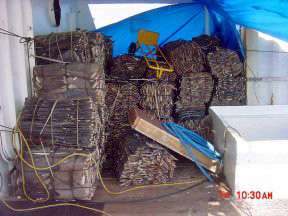
Bill Clinton signed the Shark Finning Prohibition Act of 2000 (SFPA), which banned finning on any fishing vessel within United States territorial waters and on all U.S.-flagged fishing vessels in international waters. Additionally, shark fins could not be imported into the United States without the associated carcass.[95]
In 2002, in an apparent early success in stopping the shark fin trade, the United States intercepted and seized the King Diamond II, a U.S.-flagged, Hong Kong-based vessel bound for Guatemala. The vessel was carrying 64,695 pounds (32.3 short tons; 29.3 tonnes) of baled shark fins – representing the fins of an estimated 30,000 sharks – making it the largest quantity of shark fins ever seized.[96] This seizure was reversed in court six years later: in United States v. Approximately 64,695 Pounds of Shark Fins, the Ninth Circuit Court of Appeals held that the SFPA did not cover the seized fins in this case. Judge Stephen Reinhardt found that the King Diamond II did not meet the statute's definition of a fishing vessel, since it had merely bought the fins at sea and had not aided or assisted the vessels that had caught the sharks.[97]
As a result, in January 2011, President Barack Obama signed the Shark Conservation Act into law to close the loopholes. Specifically, the new law prohibits any boat to carry shark fins without the corresponding number and weight of carcasses, and all sharks must be brought to port with their fins attached.[98][99]
Additional legislation has been proposed to ban the sale of shark fins in the United States as well. Current national bans prohibit shark finning in US waters but do not ban the sale or purchase of shark fins that were harvested elsewhere.[100] One bill, the Shark Fin Sales Elimination Act of 2019, was approved by the US House of Representatives on a bipartisan vote on 20 November 2019.[101] The bill now needs to be passed by the US Senate and then signed by the President to become law. If passed, the bill would ban the selling or buying of shark fins across the US with a fine of up to $100,000 for each offense.[101] The bill still allows for sharks to be caught for subsistence and scientific purposes.[101]
State
In 2010, Hawaii became the first state to ban the possession, sale, and distribution of shark fins. The law became effective on 1 July 2011.[102] Similar laws have been enacted in the states of Washington,[103] Oregon,[104][105] California,[106] the territory of Guam,[107] and the Commonwealth of the Northern Mariana Islands.[108] California governor Jerry Brown cited the cruelty of finning and potential threats to the environment and commercial fishing in signing the bill.[106] Opponents charged the ban was discriminatory against Chinese, the main consumers of shark fin soup, when federal laws already banned the practice of finning. Whole sharks would still be legally fished, but the fins could no longer be sold.[106]
In 2012, legislators in the New York State Assembly, including Grace Meng, introduced a similar bill, which passed in 2013. New York was not the only Eastern state considering a ban, but passage there would be significant since its Chinese-American communities in Chinatown, Manhattan and Flushing make New York the major importer of shark fins in the East. Meng admitted that while she loved shark fin soup, "it's important to be responsible citizens." Younger Chinese Americans in New York did not consider it an important part of their culture. "It's only the elderly who want it: when their grandkids get married, they want the most expensive stuff, like an emperor," said one waiter at a Chinese restaurant. Many businesses that sold fins had stopped placing new orders, expecting a ban would be passed.[109]
In April 2013, Maryland became the first state on the East Coast to enact a law against shark finning or the import of fins.[110] Texas, Illinois, Delaware, Rhode Island, and Massachusetts have also enacted bans, totaling 11 states.[111][112]
In June 2017 a bill was passed in Nevada that banned the sale or possession of body parts from sharks and several other endangered species, and outlawed shark fin soup which was becoming increasingly consumed in Nevada by visitors at casinos which made it a hub for the shark fin trade in the US.[113][114]
In January 2020 New Jersey passed a bill banning shark fins becoming the 13th state to do so. Money generated from violations of the ban would be used to fund wildlife conservation in the state.[115][116][117]
Despite these bans many restaurants are still selling shark fins due to a lack on enforcement.[118] A list of restaurants in the United States selling shark fin soup is maintained by the Animal Welfare Institute.[119]
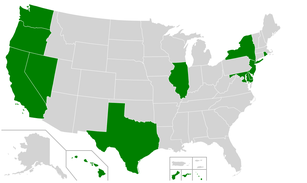
As of January 2020, 13 U.S. states and 3 U.S. territories have banned the sale and possession of shark fins:
United Nations
In recent decades, high demands and numerous forces of economic globalization have come together to create a true global mart. There has been a combination of growth and anti-finning regulations that has led fishers to view sharks as commercial species. This has unintentionally caused commercial species to be targeted rather than targeting more valuable species like tuna and swordfish. The emergence of a new market for shark fins, with addition to stricter regulations, has created a greater incentive for the full utilization of the shark. Now, this is an important aspect to consider, as where anti-finning and environmental groups can be successful in terms of decreasing the consumption and the practice of shark finning.[120]
See also
| Wikimedia Commons has media related to Shark finning. |
- Chinese imperial cuisine
- Declawing of crabs
- Endangered sharks, many sharks are endangered as a consequence of the market for shark fins
- Pain in fish
- Shark culling
- Shark fin trading in Costa Rica
References
- Schindler, D.E., Essington, T.E., Kitchell, J.F., Boggs, C. and Hilborn, R. (2002) "Sharks and tunas: fisheries impacts on predators with contrasting life histories". Ecological Applications, 12 (3): 735–748. doi:10.1890/1051-0761(2002)012[0735:SATFIO]2.0.CO;2
- Spiegel, J. (2000) "Even Jaws deserves to keep his fins: outlawing shark finning throughout global waters". Boston College International and Comparative Law Review, 24 (2): 409–438.
- Fowler, S., Séret, B. and Clarke, S. (2010) Shark fins in Europe: Implications for reforming the EU finning ban, IUCN Shark Specialist Group.
- Clarke, Shelley; Milner-Gulland, E.J.; Bjorndal, Trond (October 2007). "Social, Economic, and Regulatory Drivers of the Shark Fin Trade". Marine Resource Economics. 22 (3): 305–327. doi:10.1086/mre.22.3.42629561. Retrieved 3 April 2012.
- Buckley, Louis (2007). The End of the Line (PDF). WildAid. p. 21. Archived from the original (PDF) on 2 December 2011.
- Geoffrey York (27 August 2003). "Shark Soup". The Globe and Mail.
- Bijal P. Trivedi (17 September 2002). "Shark-Soup Boom Spurs Conservationist DNA Study". National Geographic. Retrieved 3 April 2012.
- The State of World Fisheries and Aquaculture 2014 Page 17 and 124, FAO, Rome. ISBN 978-92-5-108275-1.
- Ker Than (26 September 2006). "Shark Slaughter: 73 Million Killed Each Year". Retrieved 12 December 2019.
- Caty Fairclough (August 2013). "Shark Finning: Sharks Turned Prey". Ocean.si.edu. Retrieved 12 December 2019.
- Vannuccini, S (1999). "Shark utilization, marketing and trade. FAO Fisheries Technical Paper. No. 389. Rome, FAO".
- "Sharks". WildAid. Archived from the original on 21 May 2006. Retrieved 6 January 2007.
- Fowler, S. & Seret, B. (2010). Shark fins in Europe: implications for reforming the EU finning Ban. (Plymouth and Burnaby, BC: European Elasmobranch Association and IUCN Shark Specialist Group)
- Pollard D, Smith A (2009). "Carcharias taurus". IUCN Red List of Threatened Species. 2009: e.T3854A10132481. doi:10.2305/IUCN.UK.2009-2.RLTS.T3854A10132481.en.
- Lauren Latchford (2013). "Conservation or culture? An analysis of shark finning in the united states" (PDF). Archived from the original (PDF) on 10 October 2015. Retrieved 27 April 2017.
- Clarke, Shelley C.; McAllister, Murdoch K.; Milner-Gulland, E. J.; Kirkwood, G. P.; Michielsens, Catherine G. J.; Agnew, David J.; Pikitch, Ellen K.; Nakano, Hideki; Shivji, Mahmood S. (2006). "Global estimates of shark catches using trade records from commercial markets". Ecology Letters. 9 (10): 1115–1126. doi:10.1111/j.1461-0248.2006.00968.x. ISSN 1461-023X. PMID 16972875.CS1 maint: ref=harv (link)
- Nicholas Bakalar (12 October 2006). "38 Million Sharks Killed for Fins Annually, Experts Estimate". National Geographic. Retrieved 8 January 2007.
- BBC (UK) news item transmitted 5 March 2013
- Pauly, D.; Biery, L. (2012). "A global review of species-specific shark-fin-to-body-mass ratios and relevant legislation". Journal of Fish Biology. 80 (5): 1643–1677. doi:10.1111/j.1095-8649.2011.03215.x. PMID 22497402.
- Laura Marquez (30 October 2006). "Rising Demand For Fins Contributes To Decline in Shark Population, Critics Charge". ABC News. Archived from the original on 2 November 2007. Retrieved 8 January 2007.
- Garla, R. C.; Chapman, D. D.; Shivji, M. S.; Wetherbee, B. M.; Amorim, A. F. (2006). "Habitat of juvenile Caribbean reef sharks, Carcharhinus perezi, at two oceanic insular marine protected areas in the southwestern Atlantic Ocean: Fernando de Noronha Archipelago and Atol das Rocas, Brazil". Fisheries Research. 81 (2–3): 236–241. doi:10.1016/j.fishres.2006.07.003.
- Recovery Plan for Smalltooth Sawfish (Pristis pectinata). National Marine Fisheries Service. 2009, Retrieved 18 March 2018.
- Black, Richard (2007). "Sawfish protection acquires teeth". BBC News. Retrieved 19 March 2009.
- "List of endangered sharks". The Shark Trust. Archived from the original on 28 September 2007. Retrieved 8 January 2007.
- Convention on International Trade in Endangered Species of Wild Fauna and Flora (2013). "Appendices I, II and III". Retrieved 13 September 2013.
- Convention on International Trade in Endangered Species of Wild Fauna and Flora (2013). "The CITES Appendices". Retrieved 13 September 2013.
- "Whale Sharks". Our Endangered World.
- "Disaster off the coast of the Cocos Islands". Shark Info. Archived from the original on 7 July 2011. Retrieved 5 December 2007.
- "Shark conservation". Blue Sphere Media. Archived from the original on 5 January 2008. Retrieved 5 December 2007.
- "16 January 2007: Encountering Shark Finners inside our Marine Protected Area". Misool Eco Resort. Archived from the original on 20 August 2008. Retrieved 5 December 2007.
- "Shark finning: The cruelest cuts". The Humane Society of the United States. Retrieved 6 November 2019.
- Peter Gastrow (2001). "Triad Societies and Chinese Organised Crime in South Africa" (PDF). Institute for Security Studies.
- "Shark fisheries and trade in Europe". Shark Alliance. Retrieved 6 January 2007.
- "EU faces shark fin ban call". BBC. 25 June 2001. Retrieved 8 January 2007.
- Ian Sample (31 August 2006). "Sharks pay high price as demand for fins soars". London: The Guardian. Retrieved 8 January 2007.
- Steve Connor (31 August 2006). "Growth in shark fin trade could lead to species extinction". London: The Independent. Retrieved 31 January 2011.
- Sarah Fowler & Dr John A Musick (2 June 2006). "Shark Specialist Group Finning Statement" (PDF). IUCN Shark Specialist Group. Retrieved 8 January 2007.
- Giam Choo Hoo (1 December 2006). "Shark's fin soup – eat without guilt" (PDF). The Straits Times. Archived from the original (PDF) on 21 February 2007. Retrieved 6 January 2007.
- Eilperin, Juliet (22 February 2012). "Is the shark fin ban culturally biased?". The Washington Post. Retrieved 13 July 2013.
Here's the catch: I interviewed Giam for my book [...] and he wears a few hats. While he does participate in the Convention on International Trade in Endangered Species of Wild Fauna and Flora (CITES), he's also a representative of the shark fin industry in Singapore.
- Clarke et al. (2006a), p. 1119: "Estimates of the total number of sharks traded annually worldwide, based on all fin positions combined, ranged from 26 to 73 million... with an overall median of 38 million"
- Clarke et al. (2006b), p. 1120: "Our median biomass estimate for the global shark fin trade based on all fin positions combined (1.70 million tonnes year−1) is more than four times higher than the midrange FAO-based figure (0.39 million tonnes), and nearly three times higher than the high FAO estimate (0.60 million tonnes year−1)"
- Clarke et al. (2006c), p. 1120.
- Humane Society International; Europe (2013). "Shark finning and the European Union". Retrieved 13 September 2013.
- "Shark Finning Banned in Eastern Pacific Ocean". Environment News Service. 9 June 2005. Retrieved 8 January 2007.
- Biery L. and Pauly, D. (2012) A global review of species-specific shark-fin-to-body-mass ratios and relevant legislation, Journal of Fish Biology
- COUNCIL REGULATION (EC) No 1185/2003 of 26 June 2003 on the removal of fins of sharks on board vessels
- Banks, M. (25 September 2012). "EU parliament urged to close 'loopholes' in shark fin legislation". The Parliament.com. Retrieved 13 September 2013.
- "Save Our Sharks". Australian Marine Conservation Society. Retrieved 12 March 2019.
- "Save our Sharks". Australian Marine Conservation Society. Retrieved 12 March 2019.
- "Shark Finning Improvement Puts Northern Territory in line with World-Best Practice". Australian Marine Conservation Society. Retrieved 12 March 2019.
- Fisheries Management Act 1994, s.8 Notification – Fishing Closure (Official Notices, 2 September 2011 NSW Government Gazette No. 86 Department of Primary Industries
- https://www.cbc.ca/news/politics/tasker-shark-fin-ban-1.5161870
- Leung, Wency (17 May 2011). "Brantford first city in Canada to ban shark fin". The Globe and Mail. Retrieved 1 November 2011.
- Lem, Sharon (5 July 2011). "Shark fins banned in Oakville | Toronto & GTA | News". Toronto Sun. Retrieved 1 November 2011.
- "City moving on shark fin ban". Mississauga Article. 6 October 2011. Retrieved 1 November 2011.
- "Council Minutes May 8 2013" (PDF). mississauga.ca. 22 May 2013. Retrieved 16 April 2015.
- "Mississauga Shark Fin By-law Repealed". mississauga.ca. 10 May 2013. Retrieved 16 April 2015.
- "Toronto bans shark fin". Cbc.ca. 25 October 2011. Retrieved 1 November 2011.
- Kari, Shannon (30 November 2012). "Ontario court overturns Toronto's shark fin ban". The Globe and Mail. Retrieved 19 January 2013.
- "Newmarket the latest municipality to ban shark fin – CityNews". Citytv.com. 27 March 2012. Archived from the original on 17 June 2012. Retrieved 3 April 2012.
- "Calgary city council to draft shark fin ban bylaw". CBC. 16 July 2012. Retrieved 16 July 2012.
- "Richmond Hill avoids shark fin debate". YorkRegion Article. 25 October 2011. Retrieved 1 November 2011.
- Stewart, John (3 January 2013). "Is municipal shark fin ban dead in the water?". Metroland News. Retrieved 19 January 2013.
- "Ontario judge rules Toronto's shark fin ban invalid". CBC News Toronto. Retrieved 1 December 2012.
- "Private member's bill pushing shark fin import ban fails". CBC News Ottawa. Retrieved 28 March 2013.
- "Senate passes bill that would ban whale, dolphin captivity in Canada". CBC News. Retrieved 24 October 2018.
- "Calgary delays shark fin ban decision". CBC News Calgary. Retrieved 8 May 2013.
- "Council shelves push for shark fin ban". Calgary Herald. Retrieved 28 May 2013.
- "Media silent on shark fin soup affair". TheStandard. 1 September 2006. Archived from the original on 2 November 2007. Retrieved 8 January 2007.
- David Barboza (13 August 2006). "Waiter, There's a Celebrity in My Shark FinSoup". The New York Times. Retrieved 8 January 2006.
- "Basketball star berated for shark fin dinner". Bangkok Post. Archived from the original on 10 October 2007. Retrieved 8 January 2007.
- Mike Dolan (4 September 2006). "Death of the crocodile hunter". The First Post. Archived from the original on 30 November 2006. Retrieved 8 January 2007.
- Ken Hom (9 June 2005). "A shark's tale". The Guardian. Retrieved 8 January 2006.
- "Hong Kong shark fin imports down 50%". panda.org. 8 March 2018. Retrieved 12 December 2019.
- "Cathay Pacific targeted in shark fin protest at Hong Kong International Airport" Danny Lee, South China Morning Post, Sunday, 29 May 2016
- "Hong Kong's Cathay Pacific bans shark fin" phys.org 22 June 2018
- Shark Soup Is Off the Menu at Hong Kong Disneyland, www.nytimes.com, 25.6. 2005
- Li, Zoe (22 November 2011). "The Peninsula Hotels group bans shark fin". CNNGo.com. Archived from the original on 25 November 2011. Retrieved 3 April 2012.
- "In Pictures: Shark fin protesters gatecrash Hong Kong’s Shake Shack burger joint pop-up" Tom Grundy, Hong Kong Free Press, 16 April 2018
- "Anti-shark fin soup protesters target famous Hong Kong restaurant Maxims Palace over product's sale" abc.net.au 10 Jun 2017
- "https://www.scmp.com/news/hong-kong/economy/article/2132856/shark-fin-protest-draws-50-activists-outside-hku-branch" Danny Lee, Rachel Leung, 10 February 2018
- "Animal activists take aim at Starbucks, claiming licence holder Maxim’s continues to serve up shark fin" Jennifer Creey, Hong Kong Free Press, 14 June 2018
- "In Pictures: Animal activists protest at Maxim’s HQ over their continued sale of shark fin" Jennifer Creery, Hong Kong Free Press, 16 June 2018
- "Taiwan to Establish Shark Finning Ban". PR Newswire. 21 October 2011. Retrieved 2 December 2011.
- "No need for ban on shark hunting, finning industry, says Shabery Cheek". The Rakyat Post. 5 October 2015. Retrieved 5 October 2015.
- "ChannelNewsAsia.com, Malaysian ministry bans shark's fin soup". Channelnewsasia.com. 15 September 2007. Retrieved 1 November 2011.
- Anderton, Jim (1 April 2007). "Full protection for great white sharks starts today". New Zealand Government. Archived from the original on 16 October 2008. Retrieved 27 August 2008.
- "Save Our Sharks". Royal Forest and Bird Protection Society of New Zealand. Retrieved 27 August 2008.
- "Foodies sign pledge against shark fin soup". NZPA. 27 August 2008. Retrieved 27 August 2008.
- https://www.mpi.govt.nz/protection-and-response/sustainable-fisheries/managing-our-impact-on-marine-life/sharks/shark-finning-ban/
- "Palau pioneers 'shark sanctuary'" BBC News, 25 September 2009.
- "Leading Singaporean supermarket chain says "no" to shark fin" WWF, 30 September 2011
- "Carrefour says no to shark's fin". Yahoo! Singapore. 7 January 2012. Retrieved 4 April 2012.
- "No shark's-fin products at FairPrice from April". AsiaOne. 6 January 2012. Retrieved 4 April 2012.
- Shim, Jan (9 October 2008). "SAVE THE SHARKS SAVE THE WORLD. STOP SHARK FINNING". shimworld. Retrieved 12 January 2020.
- Raloff, Janet. "No Way to Make Soup—Thirty-two tons of contraband shark fins seized on the high seas". Science News. Retrieved 25 March 2012.
- United States v. Approximately 64,695 Pounds of Shark Fins, 520 F.3d 976, 979 (9th Cir. 2008).
- Mahr, Krista (21 December 2010). "A Happier Year in Store for America's Sharks?". Time. Retrieved 5 January 2011.
- Restuccia, Andrew (5 January 2011). "Obama signs two energy/environment bills into law". The Hill. Retrieved 5 January 2011.
- "US House passes bill banning sale of shark fins". www.seafoodsource.com. Retrieved 12 January 2020.
- "Shark Fin Sales Elimination Act of 2019 (H.R. 737)". GovTrack.us. Retrieved 12 January 2020.
- "Hawaii: Shark Fin Soup Is Off the Menu". The New York Times. Associated Press. 29 May 2010. p. A16. Retrieved 20 June 2011.
Gov. Linda Lingle signed a bill on Friday prohibiting the possession, sale, trade or distribution of shark fins, which are used in expensive Chinese dishes.
- "Washington bans sale, trade of shark fins". Seattle Times. Retrieved 1 November 2011.
- Oregon House of Representatives bills of 2011 Archived 7 October 2011 at the Wayback Machine Oregon's shark fin bill was HB 2838 by Representative Brad Witt. Passed Senate unanimously, passed House 58 to 1. Signed into law by Governor John Kitzhaber on 16 June 2011.
- "Bills Signed by Oregon Governor Kitzhaber". Data.oregon.gov. Archived from the original on 5 August 2012. Retrieved 1 November 2011.
- Harmon, Steven (8 October 2011). "Gov. Jerry Brown signs bill banning shark fins in California". San Jose Mercury News. Archived from the original on 9 December 2011. Retrieved 10 October 2011.
- "Guam Moves to Protect Sharks – Governor Calvo Signs Shark Fin Ban into Law in Guam". Thomson Reuters. 9 March 2011. Archived from the original on 11 October 2011. Retrieved 23 June 2011.
... Guam has now become the third place in the Pacific that has taken a definite stand against shark finning, the trade of fins and shark fin soup.
- "Shark Fin Possession Bill Made Law Today in Guam". Guammicronesiadivetravel.com. Archived from the original on 25 March 2012. Retrieved 1 November 2011.
- Rosenthal, Elisabeth (22 February 2012). "New York May Ban Shark Fin Sales, Following Other States". The New York Times. Retrieved 25 March 2012.
- "Maryland Becomes First State on East Coast to Ban Shark Fin Trade". The Humane Society of the United States. Retrieved 5 December 2017.
- Kirby, Matthew (4 January 2017). "Selling shark fins is now considered a crime in 11 states across America". Konbini United States. Retrieved 16 March 2018.
- Vorpahl, Amelia (22 June 2015). "Texas Becomes 10th State to Ban Trade of Shark Fins". Oceana USA. Retrieved 16 March 2018.
- McGuire, David (5 June 2017). "Nevada Governor Sandoval Signs Trafficking Bill to Protect Sharks, Rays and Wildlife". Shark Stewards. Retrieved 12 January 2020.
- Wright, Johnathan L. (5 January 2018). "Shark fin soup now illegal in Nevada". Reno Gazette Journal. Retrieved 12 January 2020.
- McGuire, David (9 January 2020). "New Jersey Governor Murphy Signs 13th Shark Fin Ban Into Law". Shark Stewards. Retrieved 12 January 2020.
- Arco, Matt (9 January 2020). "Shark fin soup now illegal in N.J. as Murphy reels in praise from conservationists". nj. Retrieved 12 January 2020.
- Racioppi, Dustin. "Murphy signs law banning shark fins in New Jersey starting in 2021". North Jersey. Retrieved 12 January 2020.
- Fobar, Rachel (16 January 2019). "Shark fin is banned in 12 U.S. states—but it's still on the menu". Animals. Retrieved 12 January 2020.
- "Restaurants Currently Offering Shark Fin Soup". Animal Welfare Institute. Retrieved 12 January 2020.
- http://www.fao.org/3/a-i4795e.pdf
